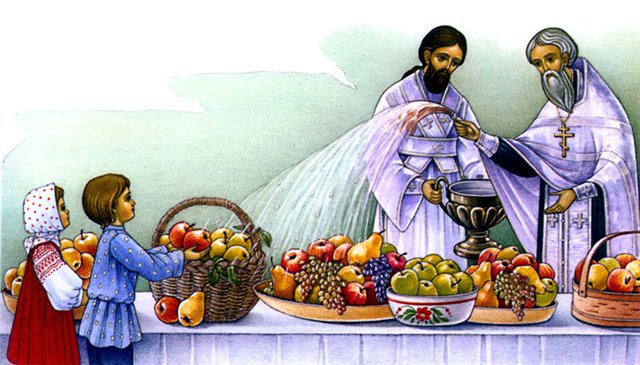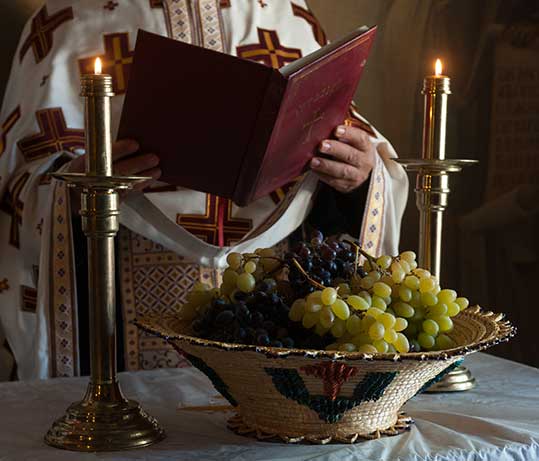According to Saint Basil the
Great, nothing exists without due cause, nothing’s fortuitous,
everything has some secret and unexpressed wisdom. Thus, regarding
plants and their fruits, apart from their ecological importance as
producers of eco-systems they’re also schools for rational souls and colleges of the knowledge of God, which train the intellect and lead it from the visible and tangible to the contemplation of things invisible.
Plants form an important element in the
worship of the Orthodox Church. During the Divine Liturgy, bread and
wine are used, the products of grain and grape. During the service of
the Blessing of the Loaves, grain, wine and oil are blessed. Besides, in
accordance with liturgical practice the fruits of the earth, such as
grapes and figs, are offered and blessed once they’re ripe. Indeed, in
general, every action and task linked to the earth and its cultivation
is accompanied either by thanksgiving to the Creator or by supplications
that the tilling and harvesting should provide plenteous amounts of
fine fruit.

There was always a tradition in the
Church that, when the bread and wine were being offered at the
Eucharist, other produce and fruits of the earth could also be offered
and blessed. But to preserve the tradition of offering only bread and
wine at the sacrament of the Divine Eucharist the Church forbade the
custom of presenting non-Eucharistic produce during the actual
celebration of the Eucharist.
All that was allowed by the Church was
the offering of grain and grapes, with the explanation that this
offering took place at the time when fruits ripened and this was to be a
blessing of the first-fruits and was by way of an expression of thanks
to God for the abundance and fertility of the earth. From as early as
the third century we have prayers for the first-fruits, thanksgiving to
God Who had given them for the gladdening and nourishment of people. The
first-fruits were brought to church as a pleasing and grateful gesture
to Him.
As regards the blessing of the fruit of
the vine we can see that this is an ancient tradition of the Church, for
which there are two ceremonies in the Service Book of the Church of
Constantinople and imperial ritual. Therefore according to ancient
custom, the Church always blessed the harvest and the grapes. Indeed, a
canon was introduced establishing that grain and bread be blessed before
they were eaten at the beginning of the harvest.

A continuation of this tradition is the
blessing of the grapes at the feast of the Transfiguration of Christ the
Saviour. We have a manuscript from the 10th century containing a prayer
through which the Church thanks God Who was pleased to ensure that the
fruit ripened, was harvested and brought gladness to people through its
taste. Wine, a product of the grape, was also offered as a gift to be
included in the celebration of the Divine Eucharist. There is also
another, later, prayer which mentions the blessing of only the grapes,
with a clear reference to the spiritual freedom guaranteed by Christ
through the Eucharistic life.
It’s interesting that in certain
liturgical rubrics, the blessing of the fruit of the vine takes place on
the feast of Dormition of the Mother of God, after the Divine Liturgy.
This was the case in Constantinople, where the Patriarch blessed the
grapes on that day, in the church of Our Lady of Blachernae, in the
presence of the Emperor. From other texts, it appears that the offering
took pace at the feast of the Elevation of the Precious Cross. It is
clear, then, that the time of the blessing of the fruit of the vine
depended on the conditions prevailing in nature in each region and on
the time at which they ripened.
If we wish to see the theological
connection between the feast and the blessing of the fruit of the vine,
our thoughts will inevitably turn to the parable of the vine, where
Christ is presented as the true vine. With the blessing of the grapes,
it is emphasized that people have a need of spiritual productivity and a
transformational advancement towards sanctity, glorification by Grace,
and communion with God. Moreover, Christ is the vine which has its roots
in heaven and its branches on earth. The body- though not the root- was
pruned and on the third day thereafter brought forth the fruit of the
Resurrection.
It follows, then, that, with the Lord’s
Transfiguration, at which His glory was revealed, the world is illumined
and glorified. Consequently, creation responds with glorification and
gratitude to this gift and the Church continues to bless the world and
it first-fruits. This blessing of the fruits emphasizes the creation’s
offering of praise and gratitude to the Creator. Besides, the grape is
the fruit that gives us wine, which we offer together with bread so that
they become the Body and Blood of Christ. By partaking of these, we
become one in body and blood with Christ.
We, as people, received the world,
blessed and sanctified, from God’s hands. Between us and our environment
there was harmony and co-operation. The Fall also brought about the
decay of creation, since thereafter it followed the same path as we did.
After our disobedience and estrangement from God we began abusing and
exploiting creation. Nature rebelled numerous times against us and
opposed us, with the result that instead of functioning constructively
and positively towards us, it often became negative and destructive. We
feel it threatens us. The turmoil in our relations with God has brought
about disruption in our relations with His creation, nature.
As Christians, however, we should not
see nature as being de-sanctified but should view it as the creation and
gift of God. We should feel that, in the world, we’re within the
creative love of God. We Christians feel the need to respond to this
love, to take elements from the material world and to offer them to God.
We bring bread and wine, representative elements of the material world,
in thanks to God and, after their sanctification, they’re offered back
to us as the Body and Blood of Christ. In this way, we acquire a
foretaste of the world as it will be transfigured in Christ in the end
times.source and thanks to: www.pemptousia.com